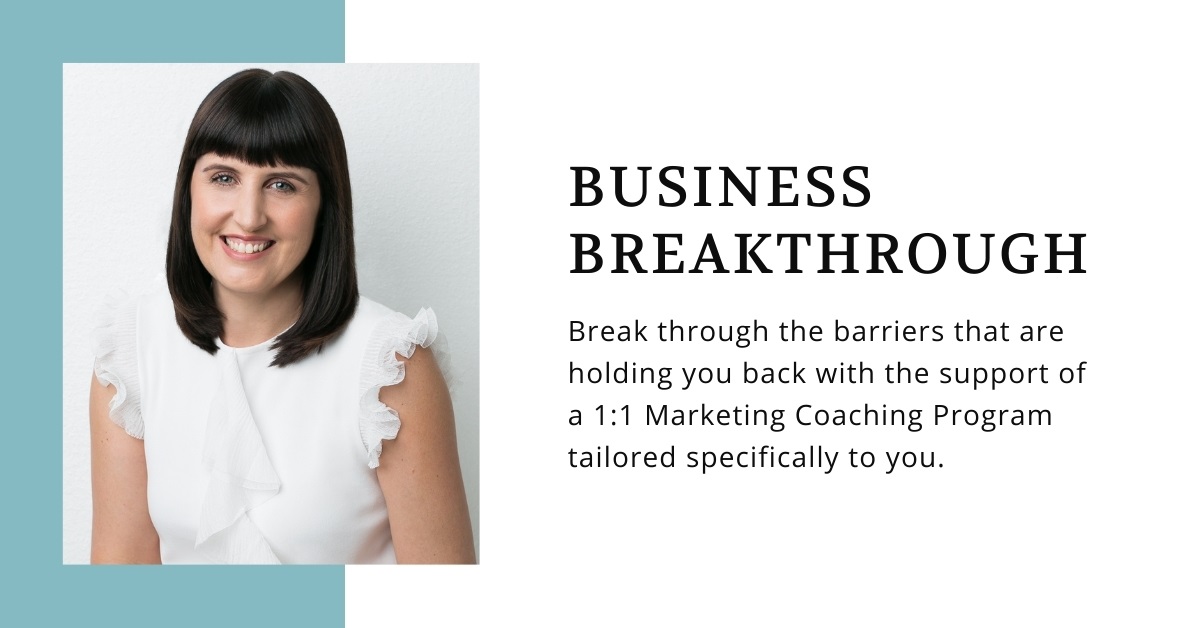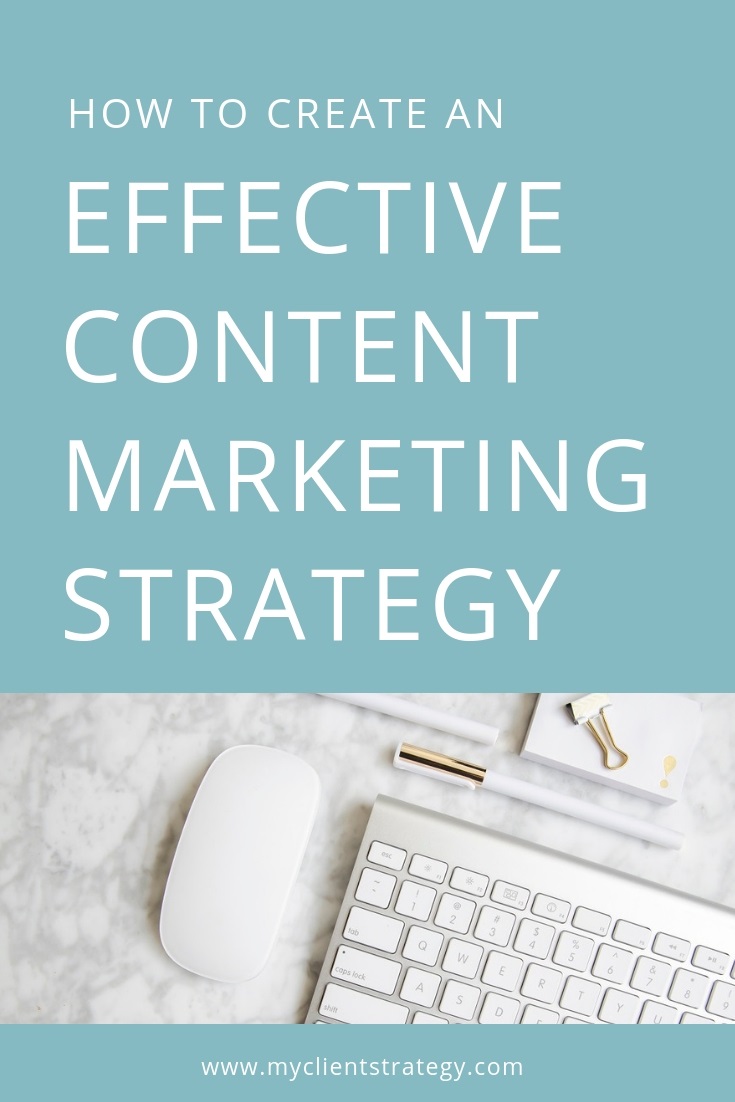How to create an effective content marketing strategy

If you’re a service-based small business, there’s no doubt you’re using a content marketing strategy to grow your business.
And why not? It’s a cost-effective way to reach your target market and a marketing strategy that’s proven to work.
Or, at least, that’s what most small business owners think until they start writing, recording and publishing content.
They find it’s not quite as easy as it looks to come up with ideas to stand out, and it can take up a lot of time.
When you consider how much content is available online, it’s no wonder it’s hard to cut through and make an impact.
That’s where having an effective content marketing strategy can make all the difference.
So, what is a content marketing strategy, and how do you create an effective one?
A content marketing strategy sits underneath those snappy blog headlines and quirky social media posts.
It provides a framework to produce content that cleverly draws the audience in and attracts your target market to your service offering without selling to them directly.
It also improves efficiency, as the same content can be strategically shared in multiple places.
No more stressing about what to write about or spending hours creating another PDF checklist because the last one you produced isn’t relevant anymore.
When creating an effective content strategy, there are some critical elements to consider, including:
- Defining your marketing goals and objectives
- Understanding whom you are creating content for
- Working out the best place to publish your content
- Deciding what types of content will be most suitable
- Coming up with ideas for what content to produce
- Determining the resources and tools needed for distributing content
- Measuring success and developing systems for repurposing content
If you’re a little unsure where to start, I’ve developed the Ultimate Marketing Checklist to help make it easier for you.
Let’s look at these critical strategic elements in more detail below.
Defining your marketing goals and objectives
Before you start creating anything, you must decide what your overarching content marketing goal is.
There’s no point in starting a blog just because everyone else is doing it.
It needs to fit in with your marketing objectives and work together with the other elements of your marketing plan.
RELATED: 7 Steps to setting marketing goals you’ll actually achieve
Whenever you create a piece of content, think about your end goal. Is it to add another subscriber to your list or showcase your authority and build trust?
Alternatively, is it to create brand awareness and increase website traffic?
Whenever you create a piece of content, think about your end goal. Share on XRegarding social media, you may also want to highlight and bring your brand values into the content you post.
For example, if you were trying to motivate or inspire your audience, you could create content that does that. On the other hand, if you were trying to teach them something, then tips and advice might be more relevant content to meet your objectives.

Understanding whom you are creating content for
Researching how your target market would search for information about you and your services is critically important.
Are they typing key phrases or words into Google? Do they search for you by your job title? Is there a customer group that they identify themselves as belonging to?
Through your research, identify what content they specifically want.
If your social media bio’s, blog headlines and content can include these specific words, you will increase your chances of being seen online.
It will be easier for your target market to find you as your Google listing will be higher, and your content will catch their eye and stand out.
One costly mistake that you’ll want to avoid is creating generic content. It comes across as dull and won’t resonate with your target market.
It’s essential to be as specific as possible and always have your audience in mind if you want to cut through and create an effective content marketing strategy.
RELATED: How to define a target market for your service business
Working out the best place to publish your content
There are numerous online platforms that you can choose from to distribute content.
However, it’s also critical that you have a content marketing strategy for your website and email list.
While social media can help you to create awareness and grow your business, you don’t own the data on those platforms and have limited control.
However, you hold your list data and control how much you communicate with them.
At a minimum, your website may include a blog and a downloadable PDF or eBook to help you grow your email marketing list.
Be sure also to use your target market keywords on your website.
Not sure where to start when it comes to finding clients for your service-based small business? That’s where I can help. Get started by downloading my free Ultimate Business Building Checklist by clicking the button below:
Regarding social media, consider how your target market uses the various platforms and which would best suit your services.
You may offer a creative or visual service (like photography or web design) suited to Instagram or Pinterest.
Or you may provide a professional service (like recruitment or consulting) that suits LinkedIn better.
Facebook still has an enormous audience, and while it is more difficult to get organic reach, it is still an important platform for you to have a presence.
Potential clients will often research your social media profiles and pages before purchase, so it’s essential that they don’t look neglected.
Whichever platforms you choose, try to focus on building your followers or connections on those accounts first before spreading yourself too thinly across all of them.
Deciding what types of content will be most suitable
The types of content in your content marketing strategy could include:
- Blog articles
- Interviews or case studies
- eBooks, checklists, guides, workbooks
- Videos or Podcasts
- Social media posts
- Emails
- Webinars or events
- Information sessions or workshop presentations
RELATED: 15 Types of content marketing you can use to stand out online
When you first start, you’ll need to decide which forms will be the most effective for your target market. And what forms of content do you think you can create productively?
For example, online technical tasks are often better explained in a video where someone can show you the steps. As well as for functions where someone is looking for a quick solution.
It can be a lot easier to work something out by watching a short how-to video on YouTube rather than spending hours reading through online guides.
Videos can also be less time-consuming for you to produce, which is why Instagram Reels, Stories, and Facebook Lives are now so popular.
Videos can also be less time-consuming for you to produce which is one reason why Facebook Lives are now so popular. #videomarketing #contentmarketing Share on XAlso, spend some time thinking about your services and the information your target market might be seeking.
For example, if you have a high-end service, your potential client will likely have a greater need for information.
Their decision-making process will be longer, and they will have more questions.
In this scenario, longer forms of high-quality content would help build greater trust with your target market and provide them with the information they want.
Setting up an automated email marketing sequence would also be an excellent way to nurture potential clients who are not ready to make a decision immediately.
Alternatively, your services may have a shorter decision-making time before purchase.
For these types of services, it’s about creating quick-to-read content consistently to build awareness of your brand.
RELATED: 20 Simple ways to get your first client
Not sure where to start when it comes to finding clients for your service-based small business? That’s where I can help. Get started by downloading my free Ultimate Business Building Checklist by clicking the button below:
Coming up with ideas for what content to produce
Writing a blog or posting on social media sounds simple, but developing ideas can be a little harder when you’re a service-based business.
You don’t have photos of your products to share, and you’re not launching new services daily.
You may also work from home, so no shop or office photos are available.
However, there are content formulas you can follow to make it so much easier.
Starting with your blog, one tip I can share is developing eight keywords that align with your brand and resonate with your target market.
Then set these keywords up as the categories for your blog and start writing one blog post for each category.
Once you’ve written your eight blog articles, return to the start and write another eight posts, one for each category.
Writing about the same topics may feel a bit restrictive or boring, but your blog will have a great structure, and those keywords will add valuable SEO to your site.
You also won’t need to come up with as many ideas for content upgrades or downloadable PDFs as you can use the same ones on multiple blog posts.
RELATED: How to choose the right keywords for your target market

Creating a content calendar to follow
When it comes to producing social media posts, make it easy for yourself by developing a structure and content marketing plan that you can follow each week.
For example, on Monday’s you may post motivational quotes, and on Wednesday’s you could give a quick tip.
Other ideas that you could add to your structure could include posting about your latest blog or podcast, or video, promoting a service that you offer, asking questions, sharing client testimonials, and posting photos of yourself (your audience needs to see you!), or a short story or behind the scenes look at your business.
You also don’t just have to share your content.
Keep an eye out for other pieces of content you think your audience will love and curate them on your feed.
RELATED: How to create a content calendar for your service business
Determining the resources and tools needed for distributing content
I highly recommend using WordPress for building your website and storing your blog content because you can install the free Yoast for SEO WordPress plugin, which is excellent for search engine optimisation (SEO).
This plugin guides you on the appropriate length for your titles and meta descriptions and prompts you to improve your writing.
I love Canva for creating my social media content and downloadable PDFs.
I use the upgraded Canva Pro version, which allows me to store my logos, images, brand colours and fonts to save time.
I manually posted all my social media content when I started my business because it was a good way for me to work out how each platform worked, and I could stay close to what other people were posting online.
However, there came the point where my time was much better spent on other things.
You mustn’t wait too long before deciding to invest in automation tools.
Once you’re comfortable, you know how it all works, then set up the tools you need.
It will not only improve your productivity, but your content will also be more consistent and effective.
That’s not to say you shouldn’t also post some ‘in the moment‘ content as well. You should, as it will add valuable timeliness and personality to your posts which is essential.
Regarding automation tools, I schedule my Instagram and Facebook page posts directly via Meta Business Suite tools and Tailwind for Pinterest. My email marketing is automated via Convertkit.
RELATED: 30 Marketing tools every service-based business should know about
Measuring success and developing systems for repurposing content
It’s essential that you track the performance of your content marketing so you know what type of material is the most effective.
It’s essential that you track the performance of your content marketing, so you know what type of material is the most effective. Share on XUse the insights platforms on your social media accounts, Google Analytics, and Google Search Console to find out what type of content is creating greater awareness, engagement and website traffic.
RELATED: 15 Ways to drive traffic to your small business website
Once you have determined this, set up systems that help you productively create similar content.
One strategy that I use is to batch my content creation. I find that when I do this, I get on a bit of a roll, and the task becomes a lot easier.
For you, this could mean writing a month’s worth of social media posts or blogs at once.
It will result in you having a lot more time during the rest of the month to focus on growing your business and serving clients instead of worrying about what to produce.
The other thing to remember is that you can share the same content across multiple platforms. You don’t need to create different content for each account.
Additionally, stretch those blog posts out as far as you can.
For example, once you post the blog article, write an email to your list about the blog article.
Then, post the blog on social media, talk about the blog in a podcast and come up with questions, quotes and short stories that link to the blog post so you can promote it and drive more traffic to your lead magnets.
Be sure to save all your content somewhere so you can return to it in a few months’ time for inspiration.
Often, you will find that you can change a word or sentence and use it again.
There is so much content out there that people don’t necessarily remember what they’ve seen in the past.
And, with the pace of social media, they might not have even seen it at all the first time around.

The keys to an effective content marketing strategy
Knowing what will resonate with your target market, having a purpose for the content you create, and establishing productive systems for what to produce and where to publish it are the keys to making your content marketing strategy effective.
Tired of trying to figure out what you’re missing when it comes to finding clients and making sales in your service business?
Break through the barriers that are holding you back with the support of an MBA-qualified Marketing Coach and Business Mentor who will tailor a 1:1 program specifically for you.

BUSINESS BREAKTHROUGH is my signature 6-month 1:1 Coaching Program for service-based business owners who want to develop the strategy, systems, and structure they need to find clients and make sales, so they can stop feeling stuck and start gaining massive momentum in their business.
Did you find this article helpful? Don’t forget to PIN to Pinterest or share on Facebook.




